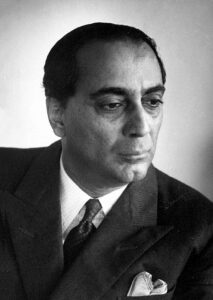
Dear Patriots,
Homi Jehangir Bhabha, a towering figure in Indian science, left an indelible mark on the nation’s scientific landscape. Born on October 30, 1909, in Mumbai to a prominent Parsi family, Bhabha’s journey from a young boy with a passion for physics to the architect of India’s nuclear program is nothing short of extraordinary. In this blog post, we delve into the life, work, key contributions, exceptional achievements, awards, and lessons for today’s youth inspired by the remarkable story of Homi Jehangir Bhabha.
Early Life and Education
Homi Jehangir Bhabha’s early years were marked by intellectual curiosity and academic excellence. Despite being born into privilege, Bhabha’s interest in science was evident from a young age. He attended Elphinstone College in Mumbai, where he excelled in his studies. However, it was his decision to pursue further education in the field of physics that would shape the course of his life. Against the wishes of some family members who expected him to pursue a career in mechanical engineering, Bhabha set his sights on Cambridge University, where he would immerse himself in the world of nuclear physics.
Work and Contributions
Bhabha’s time at Cambridge proved to be transformative. Surrounded by some of the greatest minds in the field of physics, he delved deep into the study of atomic energy and nuclear physics. It was here that he laid the groundwork for his future contributions to science. Upon returning to India, Bhabha wasted no time in applying his newfound knowledge to advance the country’s scientific capabilities. He played a pivotal role in establishing the Tata Institute of Fundamental Research (TIFR) in 1945, which would serve as a hub for cutting-edge research in various scientific disciplines, including nuclear physics.
One of Bhabha’s most significant contributions was his leadership in India’s nuclear energy program. Recognizing the potential of nuclear energy to drive India’s industrial growth, Bhabha advocated for the peaceful use of atomic energy. He played a key role in the establishment of the Bhabha Atomic Research Centre (BARC), where groundbreaking research in nuclear science and technology took place. Under his guidance, India embarked on a three-stage nuclear power program, with a focus on utilizing Thorium as a sustainable energy source—a testament to Bhabha’s visionary thinking and commitment to innovation.
Key Achievements and Awards
Throughout his illustrious career, Homi Jehangir Bhabha received numerous awards and honors in recognition of his exceptional contributions to science. In 1954, he was conferred with the prestigious Padma Bhushan award for his outstanding achievements in the field of nuclear science. Bhabha’s leadership on the global stage was also acknowledged, as evidenced by his presidency at international atomic energy conferences. Additionally, his legacy lives on through the establishment of renowned scientific institutions in his name, such as the Homi Bhabha National Institute and the Homi Bhabha Centre for Science Education.
Lessons for Today’s Youth
The life of Homi Jehangir Bhabha offers several valuable lessons for today’s youth:
- Follow Your Passions: Bhabha’s journey underscores the importance of pursuing one’s passions and interests, even if they diverge from societal expectations.
- Embrace Visionary Thinking: Bhabha’s visionary approach to nuclear energy highlights the power of forward-thinking and innovation.
- Leadership and Advocacy: Bhabha’s leadership and advocacy for the peaceful use of nuclear energy demonstrate the impact that individuals can have on shaping global discourse and policy.
- Resilience in the Face of Adversity: Despite facing setbacks and challenges, such as the tragic end to his life, Bhabha remained resilient and committed to his goals.
- Legacy and Impact: Bhabha’s enduring legacy underscores the significance of leaving a positive impact on society through one’s work.
In essence, Homi Jehangir Bhabha’s life teaches today’s youth the importance of passion, vision, leadership, resilience, and legacy-building in pursuing their own aspirations and making a meaningful impact on the world.
Conclusion
Homi Jehangir Bhabha emerged as a pioneering figure in nuclear physics and played a pivotal role in shaping India’s scientific landscape. Despite initial expectations, he pursued his passion for physics, leading to significant contributions in the field of nuclear energy. Bhabha’s visionary thinking and leadership were instrumental in establishing key research institutions like the Tata Institute of Fundamental Research and the Bhabha Atomic Research Centre (BARC). He advocated for the peaceful use of nuclear energy on the global stage and received numerous accolades for his work. His tragic death in 1966 did not diminish his legacy, as his enduring impact continues to inspire generations of scientists and innovators worldwide.
Disclaimer: This story is built based on publicly available information and compiled, edited using modern AI tools and humans.

Leave A Comment